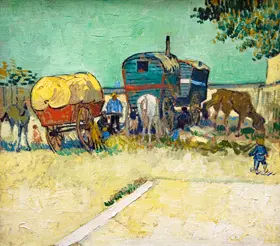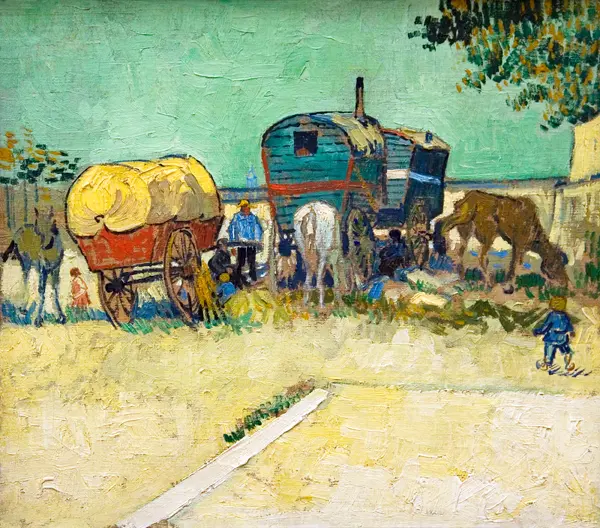About this finishing
Print. The image is printed on the top quality 10-ink HP Z9PS printer on HP matte 270 g / m2 paper. You can choose any size to an accuracy of 1 cm. A margin of 5 cm around the image is added to the size of the motif.


You can find a detailed description about our finishings
here.
Gypsy camp
Date:
1888Medium:
oil on canvasLocation:
Musee d'Orsay, Paris, FranceDimensions:
45 x 51This painting depicts a colourful scene with nomadic vehicles and figures in a natural setting. In the foreground is a yellow wagon with a covered cargo area, pulled by horses. Next to it is a blue and black residential roulotte surrounded by people. Rough brushwork and strong colours are evident, suggesting that this is a painting in the Impressionist or Post-Impressionist style. The dynamics and composition of the painting exude a sense of life on the move and community.
This description was created by artificial intelligence, please be indulgent.
Gogh painted picture Gypsy camp in 1888. Prevailing color of this fine art print is green and its shape is landscape. Original size is 45 x 51. This art piece is located in Musee d'Orsay, Paris, France. This image is printed on demand - you can choose material, size and finishing.
Vincent Willem van Gogh (1853-1890). Dutch painter belonging to
Post-Impressionism. His paintings (some 900 paintings and 1,100 drawings and sketches) are among the most famous in the world and are sold for exorbitant sums (except for those in our shop).
Parisian Impressionists He lived in Paris from 1886 and was influenced by the use of bright colours - most of his works were painted during this period. In his paintings, Gogh uses contrasting colours (often blue and orange - he said that I want to use colours other contrasts to each of them shone even more to contrast a man and a woman). He was known for his excesses and amputated an ear after the break-up of his friendship with
Gauguin. There is a lot of speculation about this incident (he possibly suffered from heavy metal poisoning from paint that had caused mental problems). In 1890, unfortunately he committed suicide.


